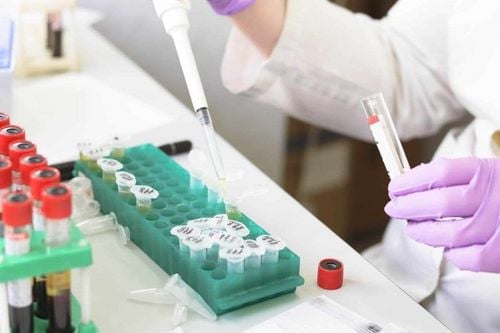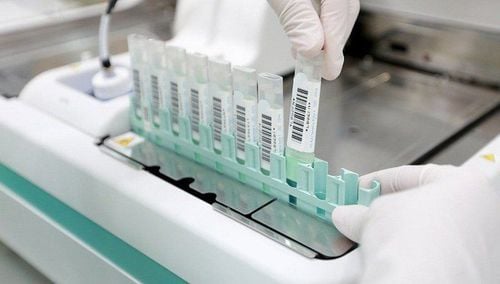This is an automatically translated article.
Posted by Dr. Nguyen Van Dinh - Head of Allergy - Clinical Immunology Unit and Doctor Le Duy Cuong, Laboratory - Vinmec Times City International HospitalIdentify the causative agent of the patient's allergy, from which it is possible to advise the patient on appropriate methods to avoid allergic reactions in the future. In patients with known allergen sensitization, specific IgE can be detected in the specimen, but the patient has no clinical symptoms.
1. Purpose of the test
The term allergy was originally defined by Clemens von Pirquet as a condition in which the body's ability to react to a foreign substance is increased. Today, the term means excessive sensitivity to foreign substances that are usually not toxic to the body.
Besides genetic predisposition, many non-genetic factors also play an important role in allergies such as: exposure to allergens, nutritional status, existing chronic diseases, acute viral infections. . Allergies tend to be inherited in conditions such as allergic asthma, rhinitis, and dermatitis (including atopic eczema).

Dị ứng có xu hướng di truyền trong các bệnh lý viêm mũi hoặc hen
2. Clinical information
The most common allergy is type 1 hypersensitivity - a condition in which specific IgE is formed. Symptoms such as rash, edema, and itching usually occur soon after exposure to the allergen. Allergens enter the body through the respiratory tract (mucous membranes) or through the gastrointestinal tract.
Respiratory allergies can be triggered by seasonal allergens (pollen, grass, moss) or non-seasonal allergens (house dust mites, pets, mold spores).
The most common food allergies are peanuts, beans, seafood, milk, eggs, nuts. Many allergens are glycoprotein in nature and in their composition have oligosaccharide branches attached to the protein framework of the allergen. In some patients, specific IgE resistance to this oligosaccharide chain appeared.
The term CCD stands for Cross-reactive carbohydrate determinant. CCD occurs in many animal and plant antigens, so the appearance of CCD-specific IgE should be taken into account when interpreting the results.
3. Semi-quantitative technique 53 IgE specific for respiratory & food allergens
At the Biochemistry unit - Vinmec International Hospital - Times City, the test is performed on an automatic EUROBlotOne machine, especially the method also allows to remove interference from CCD-specific IgE, which eliminates the reaction. cross causes false positives. The 53 allergens are designed to include common groups in life such as:Eggs and seafood: cod, shrimp, tuna, sardines Grains: flour, barley, rice, oats

Ngũ cốc là một trong những nhóm dị nguyên thường gặp trong đời sống
Nuts: soybeans, corn, peanuts, walnuts, almonds, gluten Milk: cow's milk and its ingredients, goat's milk, chocolate Fruits: tomatoes, oranges, lemons, strawberries, pineapples, apples Meats: pigs, cows, chickens Mites and furs: house dust mites, dogs, cats, chicken feathers Molds, yeasts Grasses Insects: mosquitoes, bee venom, cockroaches, fire ants 53 Allergens cover a variety of common allergens such as seafood, milk, dust mites..., suitable for all subjects, especially children.
4. Note when interpreting 53 allergen-specific IgE results
Specific IgE semi-quantitative results are not always consistent with clinical presentation for the following reasons:
Clinical symptoms are not IgE-mediated The specimen is taken before the body produces IgE. specific (after exposure to an allergen, the body needs a minimum time to produce IgE. The minimum time for the body to produce IgE specific to the allergen is 2 -3 hours, therefore if the specimen is obtained too early during this "window" the result may return negative even though the patient has symptoms of an allergy.)

Kết quả bán định lương IgE đặc hiệu có thể không tương đồng với biểu hiện lâm sàng
Specific IgE positivity also does not necessarily correlate with clinical presentation. Many specific IgEs can cross-react with different allergens or with CCD.
Food allergy often gives negative results even though the patient has clinical manifestations. This phenomenon can be explained through the effect of cooking, industrial processing, cooking, frying of food (allergens). In addition, allergic reactions can form from the metabolism of allergens in the process of digesting food (substances that are not allergenic at first, but after being digested, metabolized, metabolites, etc.). are born heterogeneous). Therefore, the diagnostic kit cannot detect IgE specifically for intermediate metabolites.
Vinmec International General Hospital is one of the hospitals that not only ensures professional quality with a team of leading medical doctors, modern equipment and technology, but also stands out for its examination and consultation services. comprehensive and professional medical consultation and treatment; civilized, polite, safe and sterile medical examination and treatment space. Customers when choosing to perform tests here can be completely assured of the accuracy of test results.
Customers can directly go to Vinmec Health system nationwide to visit or contact the hotline here for support.














